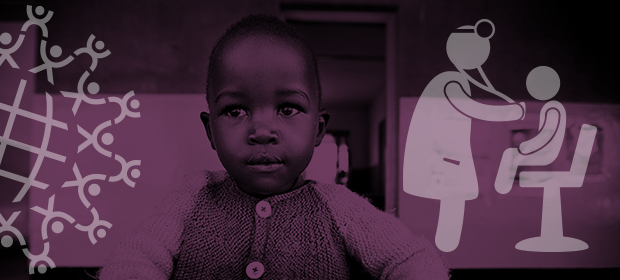Where We Work
See our interactive map


Although you may have never heard of it, you’ve probably met someone who has it.
Clubfoot is a very common birth defect causing one or both feet to turn inwards and upwards, making it nearly impossible to walk properly if left untreated. Each year an estimated 180,000 babies are born with clubfoot, 80 percent of them in countries with limited or no access to treatment, making clubfoot one of the leading causes of physical disability.
Over 1 million children around the world currently live with the pain and stigma of untreated clubfoot, and these children, due to limited mobility, are at a higher risk of poverty, illiteracy and abuse.
It is a tragedy for such a simply solved issue to be untreated in many parts of the world.
Thankfully, clubfoot can be effectively and inexpensively treated with the non-surgical Ponseti Method. This groundbreaking and now prolific treatment involves several rounds of casting the feet, followed by bracing with a boot/bar worn at night for several years in order to prevent relapse. In 95 percent of cases, proper treatment results in full correction of the feet without invasive surgery.
At miraclefeet, we believe it is a tragedy for such a simply solved issue to be untreated in many parts of the world. In fact, we believe it can be solved on a global scale and envision a world where every child can receive treatment. Miraclefeet partners with local health care providers in public hospitals to support the Ponseti treatment and to ultimately create sustainable clubfoot programs in low-resource countries.The local health care providers we work with are dedicated and driven; every day I am left in awe of what they do to bring treatment to children in their country.
Miraclefeet was founded by parents of children born with clubfoot in the United States who wanted all children to have access to the Ponseti Method, regardless of where they were born or socioeconomic status.At times, miraclefeet has encountered resistance to the Ponseti Method by surgeons who prefer surgery, but as the Ponseti Method has been accepted as the gold standard of treatment, this has changed. Acceptance of comprehensive clubfoot treatment programs varies by location, as it is never a top priority for hospitals or ministries of health. Treating clubfoot in early childhood, however, prevents a lifetime of disability.
Additionally, we’ve formed partnerships with academic and corporate institutions that have greatly catalyzed our work by helping us develop tools to make our model more effective and scalable. When expertise is needed, we also work with private partners who can help us advance our technology and our cause.When miraclefeet first started five years ago, we fielded endless requests from in-country partners that struggled with access to regularly supplied, high-quality braces that were both affordable and easy to use. We knew this was an issue that some creativity and corporate backing could potentially solve. This catapulted miraclefeet into five years (and counting!) of private partnerships.
These services—including braces, training, and patient follow-up—cost only $250 per child.
First, we approached the Stanford d.school—experts in human-centered design. They were glad to help and designed a brace. When it was time to make the design a reality, Clarks Shoes provided expertise on children’s shoe design, while Suncast optimized the bar design for manufacturability. International law firm King & Spalding filed the patent (pro bono) and Export Import Services gives us significant discounts that make shipping the braces worldwide cost-effective.The end-goal of miraclefeet’s overall strategy is the development of sustainable clubfoot treatment programs. To achieve this, miraclefeet encourages and supports activities that promote local ownership, decrease dependency, and facilitate the eventual transition of the program to the health system. When partnerships begin, we provide gap-filling services, which decrease over time. These services, such as the provision of braces, training, and patient follow-up, cost only $250 per child. The miraclefeet brace was designed at a low price point to be accessible to institutions, ministries and families when miraclefeet support is no longer needed.
From the academic institutions to privately held companies that have partnered with us, people have been at the heart of each partnership.
People want to help. All we had to do was identify the need and tell our story. Our story, that clubfoot treatment can change a child’s life, leveraged our networks on its own and we were introduced to potential partners through donors and supporters. When momentum didn’t happen naturally, we did research and made cold calls. Hearing how their company’s expertise can improve a child’s life is a compelling part of the ask. I have been moved by many of the individuals at the companies with whom we’ve partnered. Many have told me that the pro-bono project they have done for us is the most meaningful thing they have ever worked on. I have learned to believe in the best in people and to ask for help.
The brace is now in use in more than 10 countries and is available to miraclefeet partners as well as clinics and health systems that don’t receive miraclefeet support. We now have our sights set on a global plan to leverage technology and our partner network to a greater extent and reach our goal of getting treatment to every child born with clubfoot.
Check out Lauren Wall's talk about miraclefeet from SwitchPoint 2014.
Note: miraclefeet won Unite for Sight’s Global Health & Innovation Conference Innovation Prize in 2015 and was recently awarded a $1 million Impact Challenge Grant by Google.org, which supports “nonprofits that use emerging technologies to create access and opportunity for people living with disabilities.
”This post originally appeared on NextBillion.
Get the latest updates from the blog and eNews




